Lighting Ideas to Boost Your Sales
On this March issue, BNB focuses on the lighting among many ways to improve your store’s competitiveness. An effective lighting makes your displayed items look more expensive as well as brings customers back to your store in the future.
BNB interviewed stores that recently underwent an interior renovation as well as a handful of experts and lighting consultants. We boiled the result down into a collection of information that could actually help beauty supply retail store owners, avoiding the use of complex and difficult technical terms.
Why LED for beauty supplies?
Certainly, LEDs are the dominant light sources of today, and experts speak highly of them as well. Generally speaking, light bulbs used by interior design experts can be divided into incandescent bulbs, fluorescent bulbs, and LEDs.
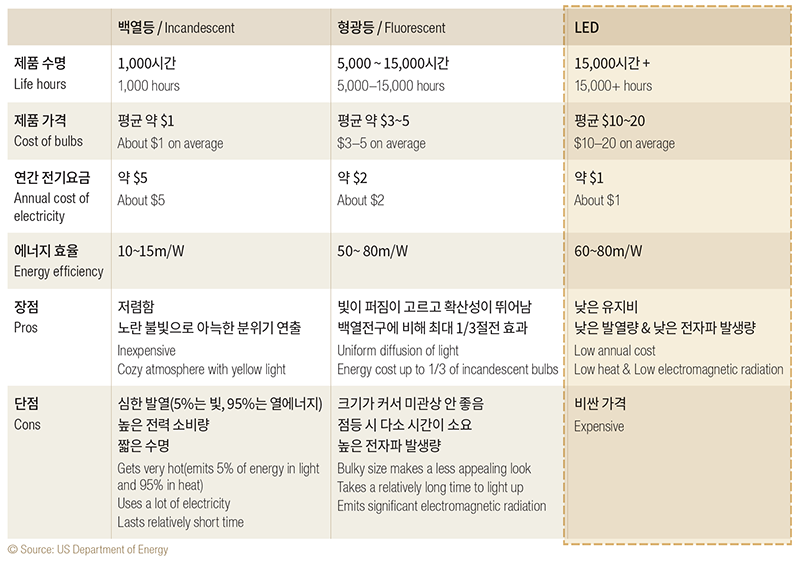
Checking out all boxes for low maintenance cost, low heat, and low electromagnetic radiation, LEDs have been adopted as the gold standard since 2010, replacing almost all traditional lighting sources in the retail. Interior contractor Mr. Y added a few more reasons for LEDs being a perfect lighting source for beauty supplies during the interview with BNB.
“Honestly, beauty supplies may do better if they could use all kinds of light sources as many as they can. Based on product categories, they can improve sales using an appropriate lighting method. I can easily tell what lighting sources work to enhance the colors of cosmetics, hair color products, and wigs to improve their appeal. However, I concluded that it does not necessary help the business. The reason is refund. I realized that many stores I worked with in an earlier time are struggling with refunds. The reason was lighting.”
Incandescent and fluorescent bulbs create a great and appealing mood, but they can actually mislead customers’ perception of colors. Customers make purchases based on the color displayed, but at home, they find the products in a different color. Although stores in need of detailed lighting arrangement such as furniture stores and clothing stores may require all three sorts of light bulbs in display, most beauty supply stores do not need such a delicate approach. You can vary the color temperature of LED bulbs to accommodate all categories of products you carry.
Basic lighting terms you should know
Lumen
Easily put, this unit indicates how much light your light bulb emits. In this measurement, you do not include lights that are not visible in human eyes.
Color Rendering Index (“CRI”)
This index marks how close your artificial light is to the natural sunlight. Most objects appear differently in colors when they are under sunlight in contrast to under an artificial light source. If your artificial light bulbs have CRI of 100, the object would appear the exactly same as it is under the sunlight. The score goes lower from there as the result differs from the sunlight. Consumers also prefer lighting that has higher CRI.
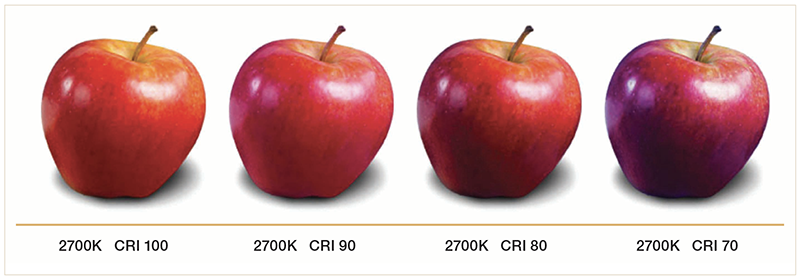
@inlineelectric.com
Kelvin (Color Temperature)
Color temperature tells you how warm your light appears, and it is measured in Kelvin. A warmer, yellower light has lower Kelvin numbers, and a cooler, bluer light has higher numbers. In general, 3000K, 4000K, 5000K, 6000K, and 6500K are primarily in use, and you can mix varying color temperatures to create the mood and more detailed display.
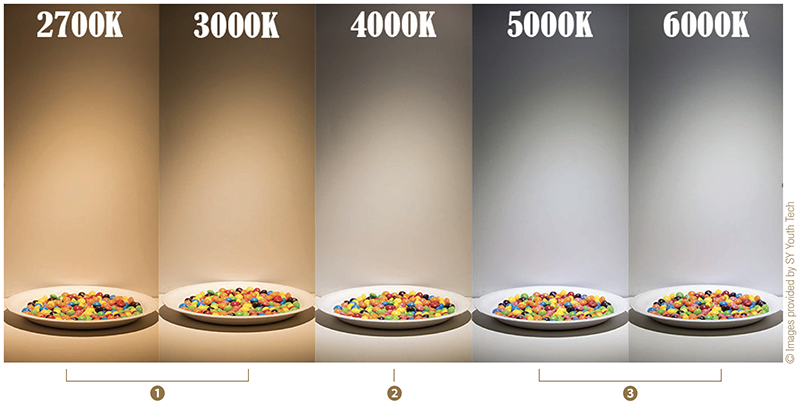
The difference in mood depending on color temperatures
1. 2700k~3000k gives warmer feel. Mainly, it is used for living rooms and shared spaces. This particular range of color temperature is rarely used in beauty supplies.
2. 4000k is by far the most frequently mentioned color temperature for general lighting. They are often used in kitchens and bathrooms, and beauty supplies should aim this color temperature for ceiling lights.
3. 5000k~6000k is very close to the natural sunlight, and it is often used for commercial lighting. You may use this color temperature range to highlight certain products and individuals. In beauty supplies, they are often used to light up the inside of display, wig cases, and as focused lights on jewelries.
Lux
To visually improve the environment, you should pay attention to how bright it is, which is measured by Lux. Lux tells you how much light is present in a certain space. We investigated how retail spaces have varying degrees of Lux in general and made the table below. You can apply your prior experience in those spaces to imagine how varying Lux would look like. Beauty supply stores should have about 900 Lux on average.

What Lux and Color Temperature does your store have?
Based on the aforementioned, you can figure out how much Kelvin and Lux your store require. You should aim for 900 to 1000 Lux and 4000 to 5000 Kelvin. Are our BNB readers doing well on the color temperature and brightness? In the past, you need a series of equipment to measure those, but now you can simply download smartphone apps to start.
[ “Lux Light Meter Pro” for measuring Lux with your phone.]
You can search the name of the application in your App Store and download it for free. You can direct your camera toward the location of interest, and you press the button to calculate lux.
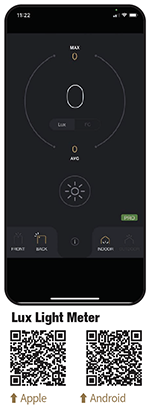
[ “LightSpectrum Pro” for measuring Kelvin with your phone. ]
It costs you $1.99 when purchased in your App Store. As soon as you launch the application, the camera will turn on. You can direct the camera toward the light source to measure its Kelvin value.
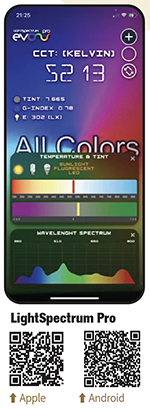
Lighting types used in beauty supplies

Base
With great diffusion characteristics, it provides ample light for a large space. Generally, you install it in the ceiling as an indirect light source.
Downlight
Most common and widely used type of lighting. It primarily refers to LED bulbs, and you mostly use it for LED bulb types with smaller sides or smaller lampshades.
Spotlight
With its focused characteristics, you utilize it in a space requiring powerful and bright spotlight. Generally, it is used for high ceiling or on stages. In beauty supplies, you can use it to highlight your featured items.
Strip lighting
With varying colors and brightness, you can use it to add a powerful illumination. It is a flexible circuit filled with LEDs and can be installed virtually anywhere. You can install it on various places such as signs, hallways, and walls.
Let’s dissect a downlight bulb currently available in the market.
Now, you should have requisite knowledge to understand the words written on the package. Here is an example of an LED light bulb package for our practice.
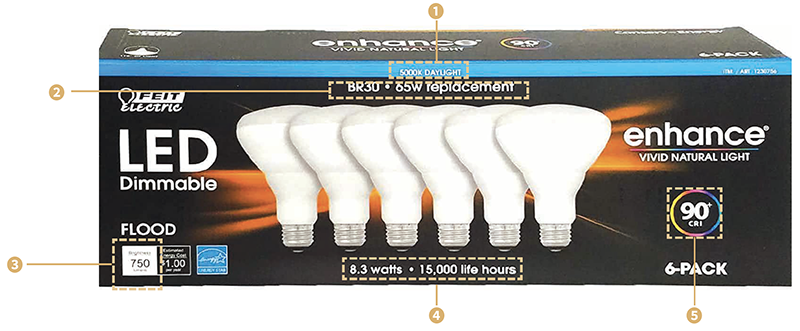
1. 750 Lumen Most light bulb manufacturers label their products with Lumen for reference for consumers’ various usages. This product carries 750 Lumen rating, and you should take the placement and angle of lighting into account to meet your lighting needs.
2. 5000K Daylight This belongs to a bluer spectrum in color temperature with 5000K. 5000K is very similar to sunlight on a clear day, and higher Kelvin values mean more bluish colors, and lower values more reddish.
3. 90 CRI 100 would show the colors as if under the sunlight, and this product with 90 can be understood as generating 90% resemblance.
4. 8.3 Watts, 15,000 life hours Watts refer to consumption of electricity, and higher the number it uses more energy. This product would last 15,000 hours while using 8.3W of energy. If you turn it on 12 hours a day, the bulb will last about 4 years.
5. BR30, 65 Watt Replacement BR stands for Bulged Reflector, meaning it has a convex lens. It refers to the shape and size, and BR30 stands for the approximate size of less than 4 inch with a convex lens. 65 Watt Replacement implies that it is so efficient as to replace 65W bulbs although it consumes only 8.3 W of electricity.
Cautions when you pick a lighting product (from a bulb company)
Among the business owners who already adopted LED lighting, some must have experienced unexpected fallout. From out-of-order light bulbs to discolored lighting cases, disfigured peripherals and so on, they can look dangerous not to mention the unpleasant look to the point where you might be better off without them. If you are business owners who want to install the lighting yourselves, you might want to know about potential side effects.
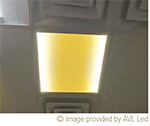
Yellow discoloration occurred in a retail store
AVL Led, who has been manufacturing and distributing LEDs in America since 2008, reminds you that you can avoid most lighting failure in advance if you take a precaution as to the followings when purchasing a lighting product.
1. Check for UL certification.
UL certifies that the product does not cause bodily injury, death, and property damages to users. This is not a mandatory certification, so some products in the market lack this certification. However, UL certification only relates to safety of the product, so it does not mean the product is better performing.
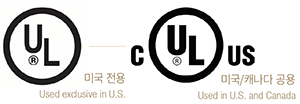
2. If you want to make sure a high performance, look for DLC certification.
How would you know a product is a high performance product? You can rely on DLC certification in this case. DLC is given to products that passed a test as to efficiency and performance, so this is the mark for high performance. About 1,800 products from 250 manufacturers are reportedly registered under the DLC certification.
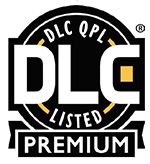
3. Prevent flicker using your phone.
While you can’t easily see with your bare eyes, flickering LED lights can cause headache and dizziness. While the side effect is serious, many consumers disregard this. Manufacturer’s instruction is silent about flicker, and you can’t examine it with your eyes. You have a simple way to check it out. Turn your smartphone camera on, and direct the camera towards the LED products. If the products have flicker, you will see black horizontal lines across your smartphone screen.

Flicker demonstrated (on the left) vs. flicker free (on the right)
How do you light your store with LEDs?
Mr. Saeyoung Kang, the owner of SY Youth Tech, has worked with beauty supply retail stores over 10 years for their lighting needs. He advises that you should have the store lighting resembling daylight as much as possible.
“Beauty supplies need to be even more close to the sunlight than other retail stores. For the projects I manage, I mix 5000K spotlights to the primary 4000K ceiling lights. This is the basic formula. Based on my experience, this mixture of lights resembles the sunlight the most. If you mix colors well, you will see stark difference in revenue.”
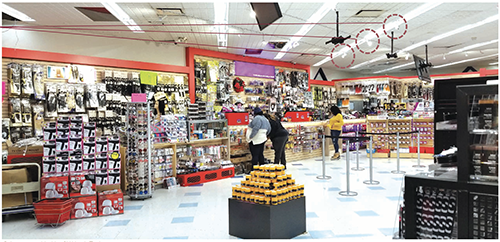
Spotlights were used sparingly in the midst of the primary ceiling lights. (Image provided by SY Youth Tech)
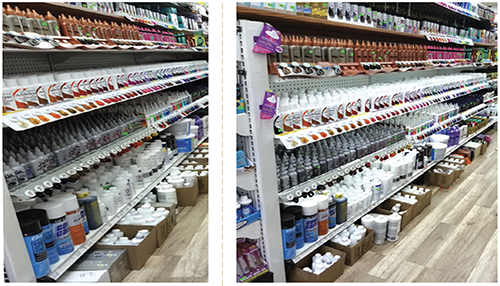
Beauty supply before the lighting update VS Beauty supply after 5000K lighting installed
Lighting tips for each product section
It is not common to adjust Lux values from place to place within a beauty supply store, so you should focus on Kelvin in prepping for light installations. The base line should be 4000–5000K for a safe bet, and you should adopt specialized strategies for each product category.
1. Jewelry: Strategic placement of 4000K and 6000K while keep 1000 Lux overall.
You should set the front of jewelry display at 4000K. If you have too blue light such as 6000K in front of the jewelry display, customers will see a pale, discouraging face in the mirrors. All skin when exposed a light as bright as sunlight will appear darker, including African Americans’.
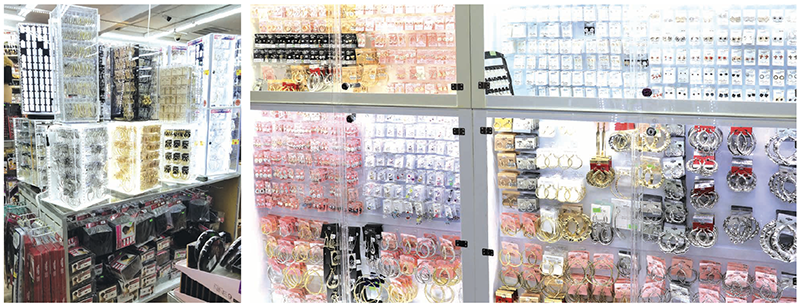
Jewelry displays employing very bright light
You can have 6000K and up for inside the jewelry display. When the light only illuminates jewelries, you can absolutely use bluer lights. You just need to differentiate lighting for jewelries and customer’s try-on mirrors.
2. Wigs: 6000K or more inside the display; 4000–5000K outside at 1000 Lux
Wigs also need color correctness. You should set the lighting at 4000K to avoid any confusion for customers.

With 4000K lighting, this retail store in the Southeast created a daylight look with occasional spotlights.

Displays with 6000K or higher color temperature for special wigs inside a retail store in the Midwest. (Images provided by SY Youth Tech)
If you have a separate place to display premium wigs, you can employ 6000K or higher color temperature to enhance the color of the wigs. In most cases, premium wigs are placed inside a display, for which you can set up a different light. In the end, if your store has 4000K ambient light, customers will notice the different colors when wigs are pulled out from the case for inspection. As such, you can catch customers’ eyes with the bright light, and then you can reveal more realistic colors upon their personal inspection or during try-on.
3. Chemicals: 5000K at 800–900 Lux within the shelves
You should install magnet-type lighting within the shelves for chemicals. You first make sure the color temperature and place it inside the shelves to illuminate chemical products, and you will see the difference in color expressions. Of course, you should set it at appropriate Kelvin value to avoid color distortion.
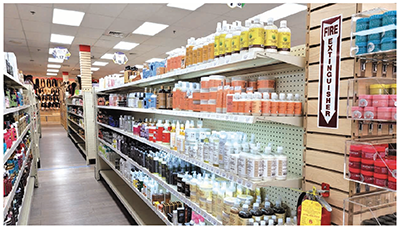
Conspicuous differences throughout chemical shelves between where additional light is installed and not.
Mr. Kang emphasized that the color temperature should be as high as possible to show off the colors while avoiding any color distortion.
“The inside the chemicals shelves should be set to 5000K. Commonly, chemical products are packaged in glass or plastic bottles. So, they reflect lights, you know? To grab people’s attention in this circumstance, you need a stronger light. But too strong of a light leads to color distortion. Based on my experience, 5000K is appropriate.”
4. Cosmetics: 5000K for inner lights, 4000K for outer, at 1000 Lux
For bright colors, you need even more brightness. The inner light bulbs should be 5000K with additional external spotlights. You should pay more attention to Lux compared to other products. When you have strongly colored cosmetics, your customers’ desire to purchase may be largely depending on lighting.
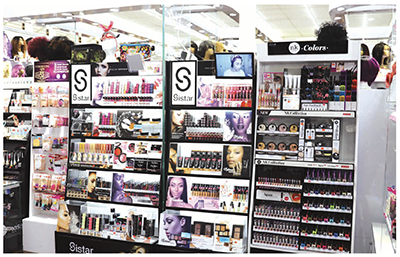
Great mixture of inner lights and spotlights used in a retail store in the Southeast
5. Accessories: primary 4000K, 5000K spotlights at 800–900 Lux
Also for accessories, you should consider color temperatures from 4000K to 5000K. The key point here is that you should apply 5000K spotlights on popular items including shoes and clothes. For example, you should focus the lighting on clothes on mannequins and seasonal shoes.

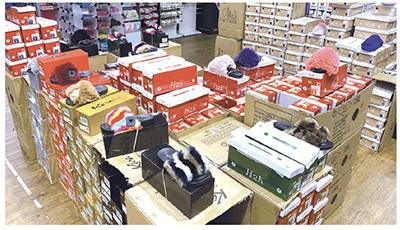
Main items are well illuminated with spotlights in a retail store in the Southeast.